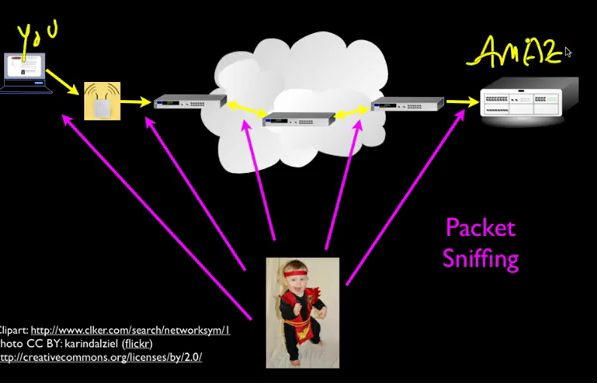Week 9
Security: Web Security
We are now on the second to last week of the class and finishing up our look at Internet Security. You can also see the final exam and its due date. The due date of the final exam signals the end of the class.
This week, we’ll be covering web security. We apply the basic ideas of encryption and signing to who we actually secure the connections that we use on today’s Web and Internet.
Securing Web Connections
Security Public/Private Key - Secure Sockets
本节介绍公开密钥加密。在前几次讲座中一直遵循着机密和完整性两个主题,机密是隐藏的,不能将其泄露给哪些你不想展示的人。
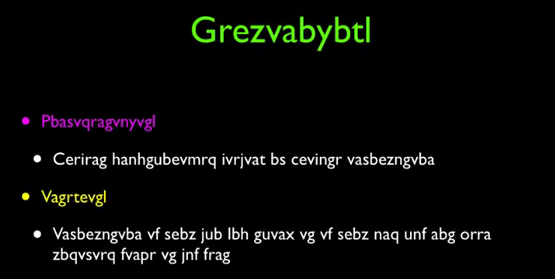
公钥加密被认为是解决这个问题的一种非常优雅的解决方案,它是由Diffie和Hellman在1976年提出的。依赖于两个密钥,且是不对称的,这就意味着我们不能像之前小节那样使用相同的密钥来进行加密。公钥实际上不需要任何保护,公钥用于消息的加密,而私钥则用于消息的解密。他们在数学上是相互关联的。

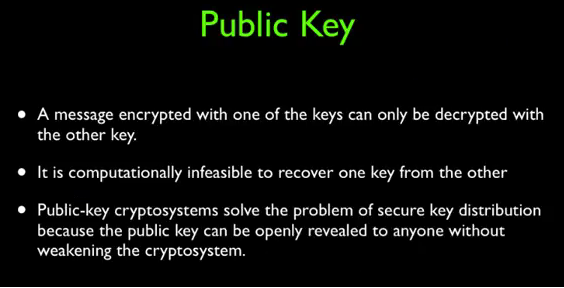
如果你想使用私密公钥加密,你必须生成一对(公钥和私钥)。
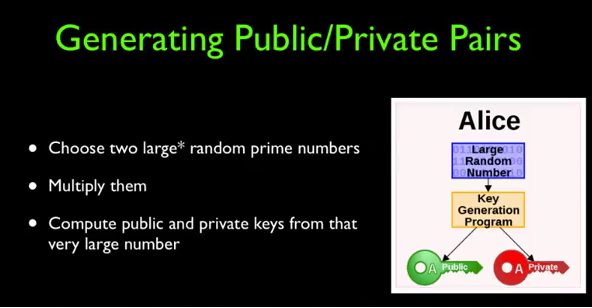
选择两个非常大的随机数,然后将它们相乘。你可以从中计算得到公钥和密钥,公钥和密钥实际上是基于两个质数,所以想要找到他们形如大海捞针。
And so the public and private key is really based on these two prime numbers.
这里老师给我们做了一个演示:
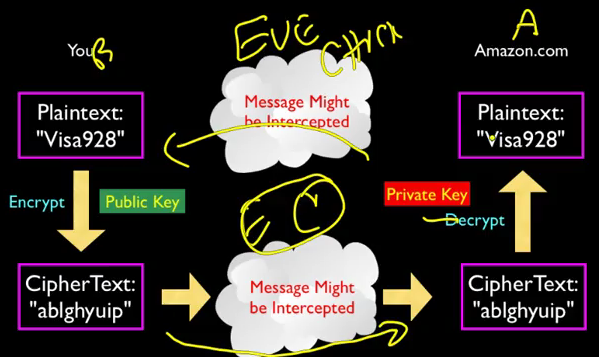
The encrypted text finds its way through all these things. And it come in encrypted. And it actually doesn't get encrypted, until it's sort of right at the point where Amazon's web server that's going to actually charge your credit card. So, this is actually beautifully elegant. In that, the rest of the network is blissfully unaware, that any encryption is happening. It's just moving the data. So, this did not require any change. Again the beauty of the layer of architecture. Did not require any change, sort of below the transport layer. And as a matter of fact, all of the sequencing and re-transmission that happens in the TCP layer. That happens with the encrypted stuff too because it's just encrypted. It's just text. It's gibberish text, it's not the original visa card number that you're sending. You're sending 123 and out comes, you know, wxy, the wxy just goes. It's re-transmitted. All this crap just works, it's like, beautiful. It's a beautiful thing. It's absolutely a beautiful thing. Then it's just like this mini layer kind of between, it's like the top slice of the transport layer. That's how I'm drawing it right here. It's like this little kind of top extra little thing, that says you know what, we're going to transport, actually help me out and give me some encryption while we're at it. And there's all kinds of cool stuff that goes back and forth. The public and private keys get exchanged.
你不得不假定你连接的过程是不安全的。
But, but basically, you know, we want to distrust all of this, okay?
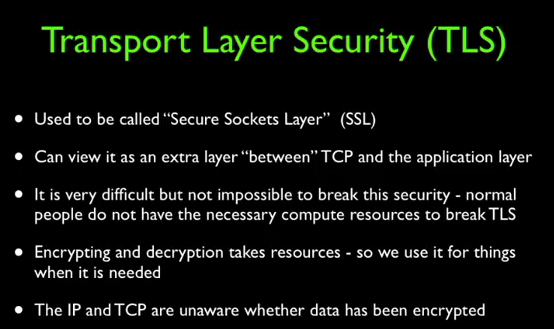
这种思想就是传输层安全(Transport Layer Security),也称作SSL、HTTPS,位于传输层和应用层之间。
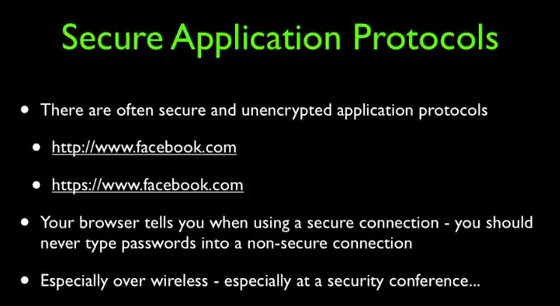
Identity on the Web
Security - Integrity and Certificate Authorities
我们如何知道与之对话的是谁呢?是亚马逊还是coursera?可以通过查看浏览器的顶部,通常这里会i有一个指示只想安全连接,可以单机此链接来查看一些信息,这就叫做证书信息。有一个GoDaddy来负责检查Coursera的ID并说,嘿你一定是Coursera的首席执行官,否则我不会给你这个签名的私钥。
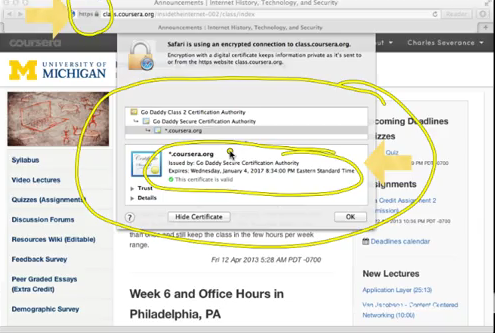
因此这就是一个获得私钥签名的过程,也是一宗确保和其他人交流的方法。所谓的数字证书也被称为签名私钥。
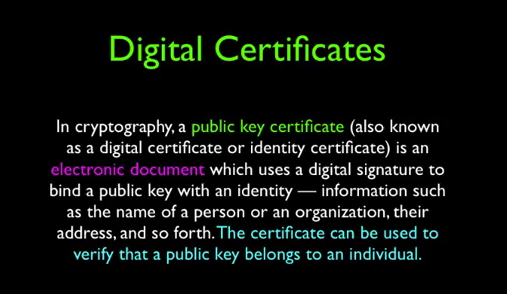
数字证书由第三方权威机构颁布,这些权威机构也是逐渐建立起信任的。

So, if you think this whole thing through, this, Eve was watching the whole time. We sent a public key. We signed and returned a public key. Then we sent the public key to your laptop. We verified the public key. And the whole time Eve is sort of watching all this information and she is powerless to break it.
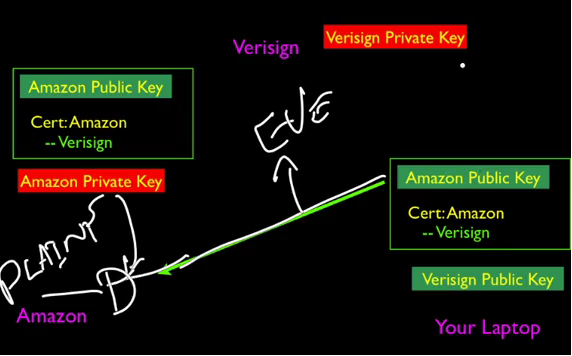
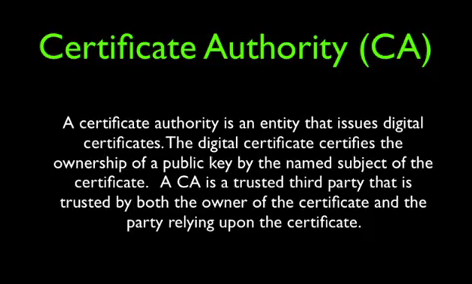
最后总结一下:
So, that sort of brings us to the conclusion of this, these last couple of lectures have been about message confidentially. And that's protecting the contents from being revealed. We use encrypting and decrypting for that. And then we have message digest. And, sur, to sign things. We've signed messages, we've signed certificates, we've signed many things, and those are important. And we talked about both sort of, shared key, and secret key, where you have to get together. And agree on a key which is a symmetric key that's used for encrypting and decrypting. And then you have the public private key which is the asymmetric. Which is one key is used for encrypting and the other key is used for decrypting. And you can freely show the encrypting key because it gives very little information. Although, it is mathematically possible, but difficult to decrypt public private key message. So, that kinds of suns up, kind of sums up our lecture on public private keys and I hope you find it valuable. See you on the net.

